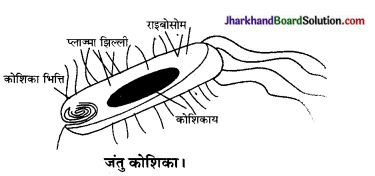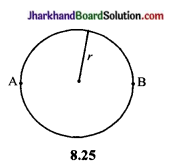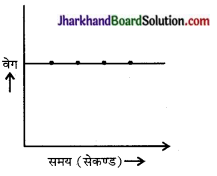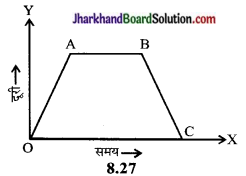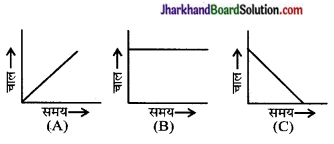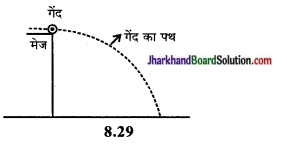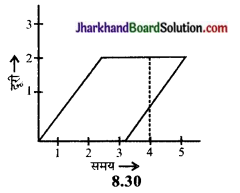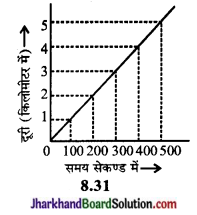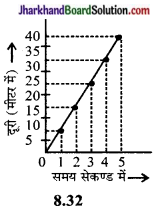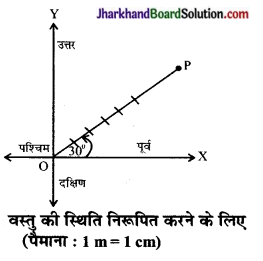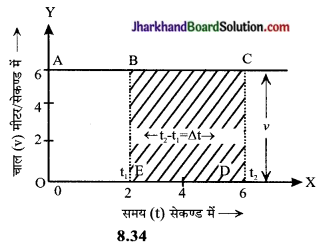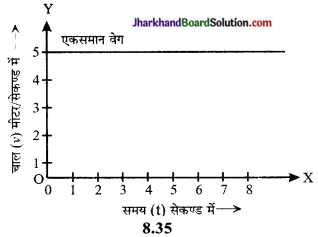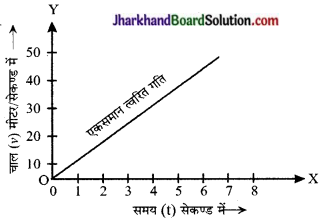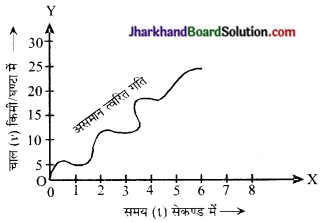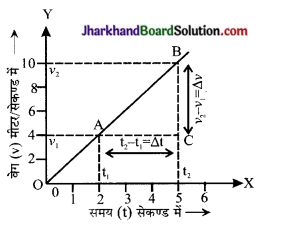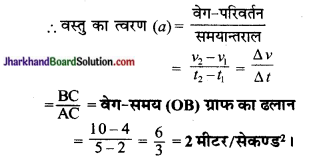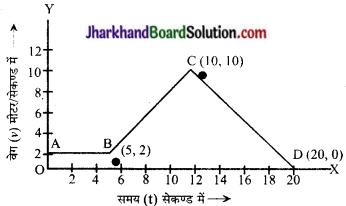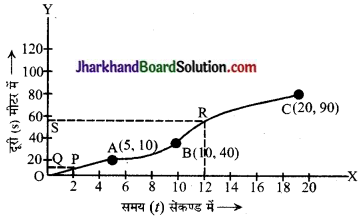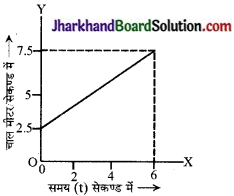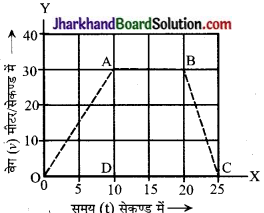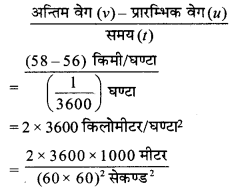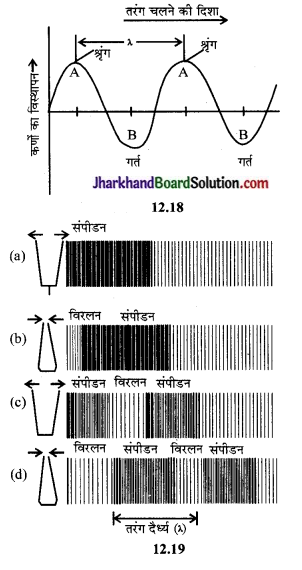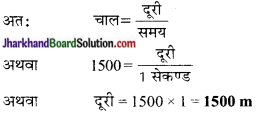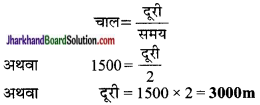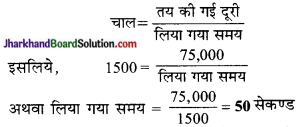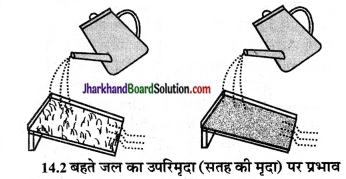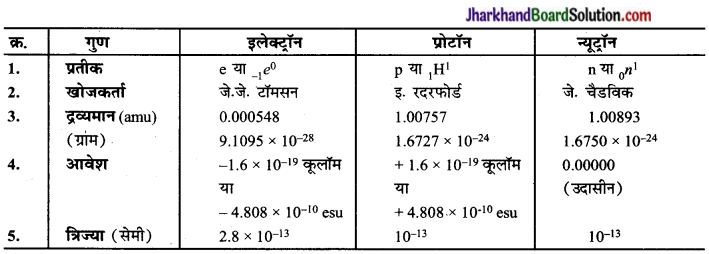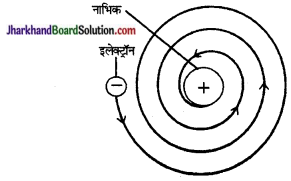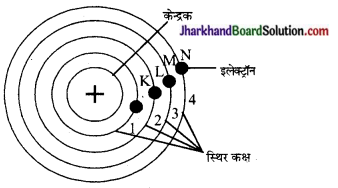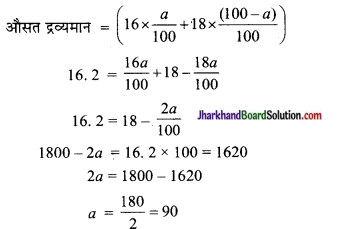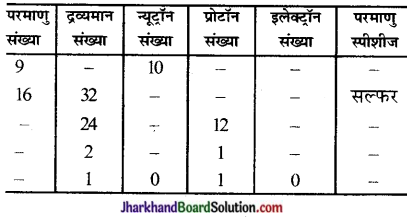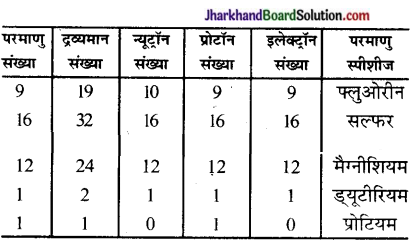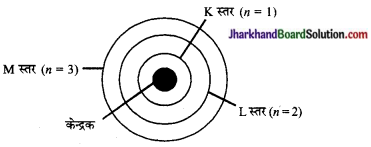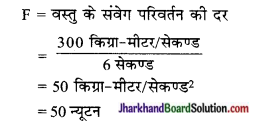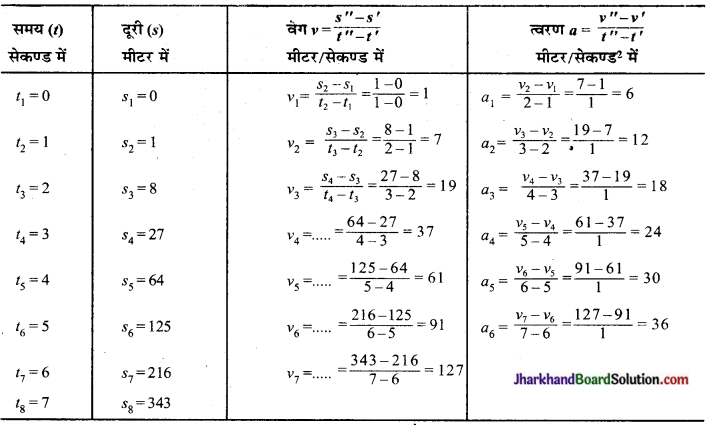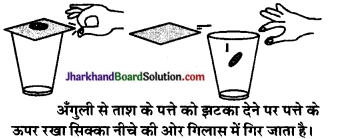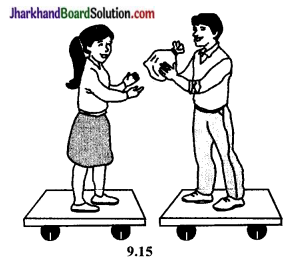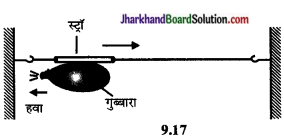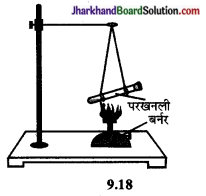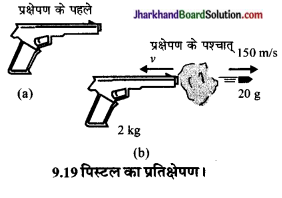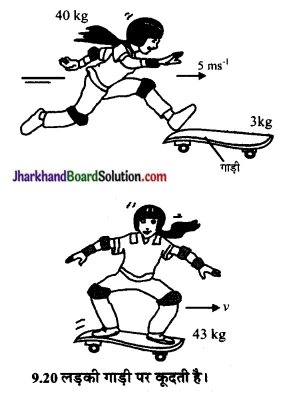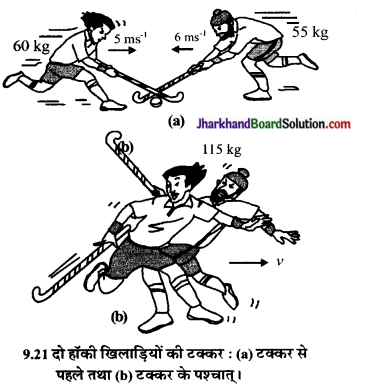Jharkhand Board JAC Class 11 Political Science Important Questions Chapter 2 स्वतंत्रता Important Questions and Answers.
JAC Board Class 11 Political Science Important Questions Chapter 2 स्वतंत्रता
बहुविकल्पीय प्रश्न
1. ‘लाँग वाक टू फ्रीडम’ किस व्यक्ति की आत्मकथा का शीर्षक है।
(अ) महात्मा गांधी
(ब) नेल्सन मण्डेला
(स) जवाहर लाल नेहरू
(द) ऑग सान सू की
उत्तर:
(ब) नेल्सन मण्डेला
2. ‘फ्रीडम फ्राम फीयर’ पुस्तक की रचयिता है।
(अ) आँग सान सू की
(ब) श्रीमती विजया लक्ष्मी पंडित
(स) सुलमान रुश्दी
(द) ऑग सान सू की
उत्तर:
(अ) आँग सान सू की
3. ” मेरे लिए वास्तविक मुक्ति भय से मुक्ति है ।” यह कथन है।
(अ) जे. एस. मिल का
(ब) लॉक का
(स) नेल्सन मण्डेला का
(द) दीपा मेहता
उत्तर:
(द) दीपा मेहता
4. नकारात्मक स्वतंत्रता से आशय है।
(अ) ऐसी स्थितियों का होना जिसमें लोग अपनी प्रतिभा का विकास कर सकें
(ब) व्यक्ति की रचनाशीलता और क्षमताओं के विकास को बढ़ावा देना
(स) युक्तियुक्ति प्रतिबन्धों से युक्त स्वतंत्रता
(द) व्यक्ति पर बाहरी प्रतिबन्धों का अभाव
उत्तर:
(द) व्यक्ति पर बाहरी प्रतिबन्धों का अभाव
![]()
5. जॉन स्टुअर्ट मिल की पुस्तक का नाम है।
(अ) लाँग वॉक टू फ्रीडम
(स) ऑन लिबर्टी
(ब) फ्रीडम फार फीयर
(द) द सेटानिक वर्सेस
उत्तर:
(स) ऑन लिबर्टी
6. निम्न में से जो पुस्तक समाज के कुछ हिस्सों में विरोध के बाद प्रतिबंधित कर दी गई, वह थी।
(अ) ऑन लिबर्टी
(ब) लाँग वाक टू फ्रीडम
(स) द सेटानिक वर्सेस
(द) फ्रीडम फार फीयर
उत्तर:
(स) द सेटानिक वर्सेस
7. ” राज्य को जहाँ तक संभव हो, व्यक्ति के मामले में हस्तक्षेप नहीं करना चाहिए।” उक्त कथन है।
(अ) लास्की का
(ब) मिल का
(स) सीले का
(द) मार्क्स का
उत्तर:
(ब) मिल का
8. निम्नांकित में से जान स्टुअर्ट मिल का राजनीतिक सिद्धान्त था
(अ) लाभ का सिद्धान्त
(ब) हानि का सिद्धान्त
(स) उपर्युक्त दोनों
(द) आदर्शवादियों द्वारा
उत्तर:
(स) उपर्युक्त दोनों
9. प्राकृतिक स्वतंत्रता की अवधारणा संबंधित है।
(अ) लास्की से
(ब) मार्क्स से
(स) रूसो से
(द) महात्मा गाँधी से
उत्तर:
(स) रूसो से
![]()
10. आर्थिक स्वतंत्रता पर सर्वाधिक जोर दिया गया था
(अ) व्यक्तिवादियों द्वारा
(ब) मार्क्सवादियों द्वारा
(स) उदारवादियों द्वारा
(द) आदर्शवादियों द्वारा
उत्तर:
(अ) व्यक्तिवादियों द्वारा
रिक्त स्थानों की पूर्ति करें
1. ……………….. के अनुसार गरिमापूर्ण मानवीय जीवन जीने के लिए जरूरी है कि हम भय पर विजय पाएं।
उत्तर:
आंग सान सू की
2. ……………….. बाहरी प्रतिबंधों का अभाव तथा ऐसी परिस्थितियों का होना है, जिनमें लोग अपनी प्रतिभा का विकास कर सकें।
उत्तर:
स्वतंत्रता
3. ………………… मेरा जन्मसिद्ध अधिकार है और मैं इसे लेकर रहूँगा।
उत्तर:
स्वराज्य
4. मिल ने ‘स्वसंबद्ध’ और ………………… कार्यों में अन्तर बताया है
उत्तर:
परसंबद्ध
5. स्वतंत्रता हमारे ” ………………….चुनने के सामर्थ्य और क्षमताओं में छुपी होती है।
उत्तर:
विकल्प
निम्नलिखित में से सत्य / असत्य कथन छाँटिये-
1. व्यक्ति पर बाहरी प्रतिबंधों का अभाव ही स्वतंत्रता है।
उत्तर:
असत्य
2. स्वतंत्रता वह स्थिति है, जिसमें लोग अपनी रचनात्मकता और क्षमताओं का विकास कर सकें।
उत्तर:
सत्य
3. हमें कुछ प्रतिबंधों की तो जरूरत है, अन्यथा समाज अव्यवस्था के गर्त में पहुँच जाएगा।
उत्तर:
सत्य
4. स्वतंत्रता पर सामाजिक असमानता से जनित प्रतिबंधों को दूर करने की जरूरत नहीं है।
उत्तर:
असत्य
5. स्वतंत्रता से जुड़े मामलों में राज्य किसी व्यक्ति को ऐसे कार्य करने से रोक सकता है जो किसी अन्य को हानि पहुँचाता हो।
उत्तर:
सत्य
निम्नलिखित स्तंभों के सही जोड़े बनाइये
| 1. जॉन स्टुअर्ट मिल | (अ) हिंद स्वराज्य |
| 2. महात्मा गाँधी | (ब) फ्रीडम फ्राम फीयर |
| 3. ऑग सान सू की | (स) लाँग वाक टू फ्रीडम |
| 4. नेल्सन मंडेला | (द) द सेटानिक वर्सेस |
| 5. सलमान रुश्दी | (य) ऑन लिबर्टी |
उत्तर:
| 1. जॉन स्टुअर्ट मिल | (य) ऑन लिबर्टी |
| 2. महात्मा गाँधी | (अ) हिंद स्वराज्य |
| 3. ऑग सान सू की | (ब) फ्रीडम फ्राम फीयर |
| 4. नेल्सन मंडेला | (स) लाँग वाक टू फ्रीडम |
| 5. सलमान रुश्दी | (द) द सेटानिक वर्सेस |
अतिलघूत्तरात्मक प्रश्न
प्रश्न 1.
स्वतंत्रता की नकारात्मक परिभाषा लिखिये।
अथवा
नकारात्मक दृष्टि से स्वतंत्रता का क्या आशय है?
उत्तर:
नकारात्मक दृष्टि से स्वतंत्रता ‘व्यक्ति पर बाहरी प्रतिबन्धों का अभाव’ है।
प्रश्न 2.
सकारात्मक दृष्टि से स्वतंत्रता से क्या आशय है?
उत्तर:
सकारात्मक दृष्टि से स्वतंत्रता ऐसी स्थितियों के होने से है जिनमें लोग अपनी प्रतिभा का विकास कर सकें।
प्रश्न 3.
स्वतंत्रता का शाब्दिक अर्थ क्या है?
उत्तर:
स्वतंत्रता का शाब्दिक अर्थ है- बन्धनों का अभाव।
![]()
प्रश्न 4.
हमें स्वतंत्रता पर प्रतिबन्धों की आवश्यकता क्यों है?
उत्तर:
हमें अपनी स्वतंत्रता को बचाने तथा एक समूह के विचारों को दूसरे समूह पर आरोपित किए बिना आपसी अंतरों पर चर्चा हो सकने की स्थिति को सुनिश्चित करने के लिए स्वतंत्रता पर प्रतिबंधों की आवश्यकता है।
प्रश्न 5.
जॉन स्टुअर्ट मिल ने व्यक्ति के कार्यों को कितने भागों में बाँटा है? उनके नाम लिखिये।
उत्तर:
मिल ने व्यक्ति के कार्यों को दो भागों:
- स्व-सम्बद्ध कार्य
- पर सम्बद्ध कार्य में बाँटा है।
प्रश्न 6.
स्वतंत्रता के लिए संघर्ष से जुड़े किन्हीं दो व्यक्तियों के नाम लिखो।
उत्तर:
- नेल्सन मण्डेला और
- ऑग सान सू की।
प्रश्न 7.
ऑग सान सू की किस देश की हैं? और उन्हें संघर्ष की प्रेरणा कहाँ से प्राप्त हुई?
उत्तर:
ऑग सान सू की म्यांमार की हैं और गाँधीजी के अहिंसा के विचारों से उन्हें संघर्ष की प्रेरणा मिली।
प्रश्न 8.
ऑग सान सू की कां एक मुख्य विचार बताइए।
उत्तर:
आँग सान सू की के अनुसार गरिमापूर्ण मानवीय जीवन जीने के लिए आवश्यक है कि हम भय पर विजय पाएं।
प्रश्न 9.
स्व-सम्बद्ध कार्य कौनसे हैं?
उत्तर:
स्व-सम्बद्ध कार्य वे हैं जिनके प्रभाव केवल इन कार्यों को करने वाले व्यक्ति पर पड़ते हैं।
![]()
प्रश्न 10.
पर-सम्बद्ध कार्य कौनसे हैं?
उत्तर:
पर-सम्बद्ध कार्य वे हैं जिनका प्रभाव कर्ता के साथ-साथ अन्य लोगों पर भी पड़ता है।
प्रश्न 11.
भारतीय राजनीतिक विचारों में स्वतंत्रता की समानार्थी अवधारणा क्या है?
उत्तर:
भारतीय राजनीतिक विचारों में स्वतंत्रता की समानार्थी अवधारणा है स्वराज।
प्रश्न 12.
लोकमान्य तिलक ने ‘स्वराज्य’ के बारे में क्या कहा था?
उत्तर:
लोकमान्य तिलक ने कहा था कि ‘स्वराज्य मेरा जन्मसिद्ध अधिकार है और मैं इसे लेकर रहूँगा!’
प्रश्न 13.
एक स्वतंत्र समाज कौनसा होता है?
उत्तर:
एक स्वतंत्र समाज वह होता है जिसमें व्यक्ति अपने हित संवर्धन न्यूनतम प्रतिबंधों के बीच करने में स्वतंत्र
प्रश्न 14.
स्वतंत्रता को बहुमूल्य क्यों माना जाता है?
उत्तर:
स्वतंत्रता को बहुमूल्य इसलिए माना जाता है क्योंकि इससे व्यक्ति अपने विवेक और निर्णय की शक्ति का प्रयोग कर पाते हैं।
प्रश्न 15.
किन्हीं दो प्रतिबंधित नाटकों के नाम लिखिये।
उत्तर:
- द लास्ट टेम्पटेशन आफ क्राइस्ट
- रामायण रिटोल्ड
प्रश्न 16.
द सेटानिक वर्सेस पुस्तक के लेखक का नाम लिखिये।
उत्तर:
सलमान रुश्दी।
प्रश्न 17.
‘ऑन लिबर्टी’ पुस्तक की रचना किसने की थी?
उत्तर:
जान स्टुअर्ट मिल।
प्रश्न 18.
नेल्सन मंडेला ने किस देश की आजादी के लिए संघर्ष किया?
उत्तर:
दक्षिण अफ्रीका।
प्रश्न 19.
मंडेला ने किसके लिए संघर्ष किया था?
उत्तर:
मंडेला ने श्वेत और अश्वेत दोनों लोगों के लिए संघर्ष किया था।
प्रश्न 20.
जॉन स्टुअर्ट मिल ने किन दो कार्यों में अन्तर बताया था?
उत्तर:
स्व-संबद्ध और पर संबद्ध कार्यों में।
![]()
प्रश्न 21.
‘मानव स्वतंत्र पैदा होता है लेकिन वह प्रत्येक जगह जंजीरों से जकड़ा हुआ है ।” उक्त विचार किस विद्वान से संबंधित हैं ?
उत्तर:
जीन जैक्स रूसो से।
प्रश्न 22.
जॉन स्टुअर्ट मिल के अनुसार स्वतंत्रता का अधिकार किस आधार पर प्रतिबंधित किया जा सकता है?
उत्तर:
मिल के अनुसार, स्वतंत्रता से जुड़े मामलों में राज्य किसी व्यक्ति को ऐसे कार्य करने से रोक सकता है जो किसी अन्य को गंभीर हानि पहुँचाता हो। अर्थात् स्वतंत्रता का अधिकार ‘हानि सिद्धान्त’ के आधार पर प्रतिबंधित किया जा सकता है।
प्रश्न 23.
मिल के अनुसार छोटी-मोटी हानि के लिए व्यक्ति के विरुद्ध कौन-सी कार्यवाही करनी चाहिए?
उत्तर:
मिल के अनुसार छोटी-मोटी हानि के लिए व्यक्ति के विरुद्ध केवल सामाजिक असहमति दर्शानी चाहिए।
लघूत्तरात्मक प्रश्न
प्रश्न 1.
स्वतंत्रता के लिए संघर्ष लोगों की किस आकांक्षा को दिखाता है?
उत्तर:
स्वतंत्रता के लिए संघर्ष लोगों की इस आकांक्षा को दिखाता है कि वे अपने जीवन और नियति का नियंत्रण स्वयं करें तथा उनका अपनी इच्छाओं और गतिविधियों को स्वतंत्रता से व्यक्त करने का अवसर बना रहे ।
प्रश्न 2.
व्यक्ति की स्वतंत्रता की कुछ सीमाएँ क्यों आवश्यक हैं?
उत्तर:
व्यक्ति की स्वतंत्रताओं की कुछ सीमाएँ इसलिए आवश्यक हैं कि
- ये सीमाएँ हमें असुरक्षा से मुक्त करती हैं।
- ये सीमाएँ ऐसी स्थितियाँ प्रदान करती हैं, जिनमें हम अपना विकास कर सकें।
प्रश्न 3.
मंडेला व उनके साथियों के लिए ‘लाँग वॉक टू फ्रीडम’ क्या था?
उत्तर:
मंडेला व उनके साथियों के लिए दक्षिण अफ्रीका के रंगभेदी शासन के अन्यायपूर्ण प्रतिबन्धों और स्वतंत्रता के रास्ते की बाधाओं को दूर करने का संघर्ष ‘लाँग वाक टू फ्रीडम’ था।
प्रश्न 4.
नकारात्मक दृष्टि से स्वतंत्रता का क्या आशय है?
अथवा
स्वतंत्रता का नकारात्मक दृष्टिकोण किन विचारों पर आधारित है?
उत्तर:
स्वतंत्रता का नकारात्मक दृष्टिकोण अग्र विचारों पर आधारित है।
- स्वतंत्रता का अभिप्राय है प्रतिबन्धों का अभाव।
- व्यक्ति पर राज्य का कोई नियंत्रण नहीं होना चाहिए।
- वह सरकार सर्वोत्तम है जो कम-से- -कम शासन करे।
![]()
प्रश्न 5.
सकारात्मक दृष्टि से स्वतंत्रता का क्या आशय है?
उत्तर:
सकारात्मक दृष्टि से स्वतंत्रता का आशय है-ऐसी स्थितियों का होना जिनमें सभी लोग अपने व्यक्तित्व का विकास कर सकें। इस अर्थ में स्वतंत्रता व्यक्ति की रचनाशीलता, संवेदनशीलता और क्षमताओं के भरपूर विकास को बढ़ावा देती है।
प्रश्न 6.
संक्षेप में बताइये कि क्या पूर्ण स्वतंत्रता संभव है?
उत्तर:
पूर्ण स्वतंत्रता संभव नहीं है क्योंकि पूर्ण स्वतंत्रता से आशय है कि व्यक्ति के कार्यों पर किसी भी प्रकार का कोई प्रतिबन्ध न हो, वह मनमाना व्यवहार कर सके। ऐसा करने पर अराजकता की स्थिति पैदा हो जायेगी और स्वतंत्रता नष्ट हो जायेगी।
प्रश्न 7.
हमें स्वतंत्रता पर प्रतिबन्धों की आवश्यकता क्यों है?
उत्तर:
- हमें सामाजिक व्यवस्था को बनाए रखने के लिए स्वतंत्रता पर प्रतिबन्धों की आवश्यकता है।
- हमें अपनी स्वतंत्रता को बचाने के लिए भी कानूनी संरक्षण हेतु प्रतिबन्धों की आवश्यकता है।
प्रश्न 8.
हानि का सिद्धांन्त क्या है?
उत्तर:
सभ्य समाज के किसी सदस्य की इच्छा के खिलाफ शक्ति के औचित्यपूर्ण प्रयोग का एकमात्र उद्देश्य किसी अन्य को हानि से बचाना हो सकता है।” यही मिल का हानि का सिद्धान्त है। इस सिद्धान्त के अनुसार, स्वतंत्रता से जुड़े मामलों में राज्य किसी व्यक्ति को ऐसे कार्य करने से रोक सकता है, जो किसी अन्य को हानि पहुँचाता हो। लेकिन प्रतिबंध लगाने के लिए आवश्यक है कि किसी को होने वाली हानि गंभीर हो।
प्रश्न 9.
” स्वतंत्रता व्यक्ति पर बाहरी प्रतिबन्धों का अभाव है।” इस कथन को स्पष्ट कीजिये।
उत्तर:
इस कथन का आशय यह है कि यदि किसी व्यक्ति पर बाहरी नियंत्रण या दबाव न हो और वह बिना किसी पर निर्भर हुए निर्णय ले सके तथा स्वायत्त तरीके से व्यवहार कर सके, तो वह व्यक्ति स्वतंत्र माना जा सकता है । इस कथन का व्यावहारिक अर्थ है। उन सामाजिक प्रतिबन्धों का कम-से-कम होना जो हमारी स्वतंत्रतापूर्वक चयन की क्षमता पर रोक-टोक लगाते हैं
प्रश्न 10.
” स्वतंत्रता ऐसी स्थितियों का होना है जिनमें लोग अपनी प्रतिभा का विकास कर सकें ।” इस कथन को स्पष्ट कीजिए।
उत्तर:
इस कथन का आशय यह है कि स्वतंत्र होने के लिए समाज को उन बातों को विस्तार देना चाहिए, जिससे व्यक्ति, समूह, समुदाय राष्ट्र अपने भाग्य, दिशा और स्वरूप का निर्धारण करने में समर्थ हो सकें । अतः स्वतंत्रता वहं स्थिति है जिसमें लोग अपनी रचनात्मकता और क्षमताओं का भरपूर विकास कर सकें।
प्रश्न 11.
व्यक्ति की स्वतंत्रता पर प्रतिबन्धों के स्रोतों का उल्लेख कीजिये।
उत्तर:
प्रतिबन्धों के स्रोत:
- व्यक्ति की स्वतंत्रता पर प्रतिबंध प्रभुत्व और बाहरी नियंत्रण से लग सकते हैं। ये प्रतिबंध बलपूर्वक या सरकार द्वारा ऐसे कानून की मदद से लगाए जा सकते हैं, जो शासकों की ताकत का प्रतिनिधित्व करें।
- स्वतंत्रता पर प्रतिबंध सामाजिक असमानता के कारण भी हो सकते हैं जैसा कि जाति व्यवस्था में होता है।
- समाज में अत्यधिक आर्थिक असमानता के कारण भी स्वतंत्रता पर अंकुश लग सकते हैं।
![]()
प्रश्न 12.
राष्ट्रीय स्वतंत्रता से क्या आशय है?
उत्तर:
राष्ट्रीय स्वतंत्रता का अर्थ है। स्वराज्य की प्राप्ति। राष्ट्रीय स्वतंत्रता के अन्तर्गत प्रत्येक राष्ट्र का यह अधिकार है कि वह स्वतंत्रतापूर्वक अपनी नीतियों का निर्धारण कर सके तथा उन्हें लागू कर सके। परतंत्र देशों द्वारा अपने राष्ट्र की स्वतंत्रता की मांग करना राष्ट्रीय स्वतंत्रता है। 20वीं शताब्दी में अफ्रीका व एशिया के बहुत से देशों ने अपनी राष्ट्रीय स्वतंत्रता प्राप्त की।
प्रश्न 13.
स्वतंत्रता के सकारात्मक पक्ष की दो विशेषताएँ लिखिये।
उत्तर:
स्वतंत्रता के सकारात्मक पक्ष की दो प्रमुख विशेषताएँ ये हैं।
- सकारात्मक स्वतंत्रता के समर्थक उचित प्रतिबन्धों को स्वीकार करते हैं लेकिन वे अनुचित प्रतिबंधों के विरोधी हैं।
- सकारात्मक स्वतंत्रता का सम्बन्ध समाज की सम्पूर्ण दशाओं से है, न कि केवल कुछ क्षेत्र से।
प्रश्न 14.
अभिव्यक्ति की स्वतंत्रता का क्या अर्थ है?
उत्तर:
अभिव्यक्ति की स्वतंत्रता से यह आशय है कि प्रत्येक व्यक्ति को अपने विचारों को दूसरों या समाज के समक्ष व्यक्त करने की स्वतंत्रता होनी चाहिए। अभिव्यक्ति की स्वतंत्रता के अन्तर्गत भाषण देने तथा लेखन द्वारा अभिव्यक्ति की स्वतंत्रता भी शामिल है।
प्रश्न 15.
स्वतंत्रता की नकारात्मक और सकारात्मक अवधारणा में कोई दो अन्तर लिखिये।
उत्तर:
- स्वतन्त्रता की नकारात्मक अवधारणा स्वतंत्रता को बाहरी नियंत्रणों के अभाव के रूप में देखती है जबकि सकारात्मक अवधारणा व्यक्ति के व्यक्तित्व के विकास के अवसरों के विस्तार के रूप में देखती है।
- नकारात्मक स्वतंत्रता में राज्य का व्यक्ति पर बहुत सीमित नियंत्रण होता है जबकि सकारात्मक स्वतंत्रता में राज्य व्यक्ति के कल्याण के लिए उसके सभी क्षेत्रों में हस्तक्षेप कर सकता है।
प्रश्न 16.
नेल्सन मंडेला की आत्मकथा ‘लॉंग वाक टू फ्रीडम’ पर संक्षिप्त टिप्पणी लिखिये।
उत्तर:
लॉंग वाक टू फ्रीडम (स्वतंत्रता के लिए लम्बी यात्रा): इस पुस्तक में मंडेला ने दक्षिण अफ्रीका के रंगभेदी शासन के खिलाफ अपने व्यक्तिगत संघर्ष, गोरे लोगों के शासन की अलगाववादी नीतियों के खिलाफ लोगों के प्रतिरोध और दक्षिण अफ्रीका के रंगभेदी शासन के खिलाफ अपने व्यक्तिगत संघर्ष, गोरे लोगों के शासन की अलगाववादी नीतियों के खिलाफ लोगों के प्रतिरोध और दक्षिण अफ्रीका के काले लोगों द्वारा झेले गए अपमान, कठिनाइयों और पुलिस अत्याचार का वर्णन किया गया है।
इन अलगाववादी नीतियों में एक शहर में घेराबंदी किए जाने और देश में मुक्त आवागमन पर रोक लगाने से लेकर विवाह करने में मुक्त चयन तक पर प्रतिबंध लगाना शामिल है। सामूहिक रूप से इन सभी प्रतिबन्धों को नस्ल के आधार पर भेदभाव करने वाली रंगभेदी सरकार ने जबरदस्ती लागू किया था। मंडेला और उनके साथियों के लिए इन्हीं अन्यायपूर्ण प्रतिबंधों और स्वतंत्रता के रास्ते की बाधाओं को दूर करने का संघर्ष ‘लॉंग वाक टू फ्रीडम’ था। मंडेला का यह संघर्ष काले और अन्य लोगों के साथ-साथ श्वेत लोगों के लिए भी था।
प्रश्न 17.
स्वतंत्रता की अवधारणा के नकारात्मक व सकारात्मक पक्ष को स्पष्ट कीजिये। स्वतंत्रता की अवधारणा को स्पष्ट कीजिये।
अथवा
उत्तर:
स्वतंत्रता की अवधारणा: स्वतंत्रता बाहरी प्रतिबन्धों का अभाव और ऐसी स्थितियों का होना है, जिनमें लोग अपनी प्रतिभा का विकास कर सकें। स्वतंत्रता की इस अवधारणा के दो पक्ष हैं।
- नकारात्मक पक्ष और
- सकारात्मक पक्ष। यथा
1. स्वतंत्रता का नकारात्मक पक्ष:
स्वतंत्रता का नकारात्मक पक्ष यह है कि ‘व्यक्ति पर बाहरी प्रतिबंधों का अभाव ही स्वतंत्रता है।’ इसका अभिप्राय यह है कि यदि किसी व्यक्ति पर बाहरी नियंत्रण या दबाव न हो और वह बिना किसी पर निर्भर हुए निर्णय ले सके तथा स्वायत्त तरीके से व्यवहार कर सके, तो वह व्यक्ति स्वतंत्र माना जा सकता है। लेकिन समाज में रहने वाला कोई भी व्यक्ति हर किस्म की सीमा और प्रतिबन्धों की पूर्ण अनुपस्थिति की आशा नहीं कर सकता। इसलिए यहाँ स्वतंत्र होने का अर्थ उन सामाजिक प्रतिबन्धों का कम से कम होना है, जो हमारी स्वतंत्रतापूर्वक चयन करने की क्षमता पर रोक-टोक लगाए।
2. स्वतंत्रता का सकारात्मक पक्ष:
स्वतंत्रता का सकारात्मक पक्ष यह है कि ऐसी स्थितियों का होना जिनमें लोग अपनी प्रतिभा का विकास कर सकें। इसका अभिप्राय यह है कि स्वतंत्र होने के लिए समाज को उन बातों का विस्तार देना चाहिए जिससे व्यक्ति, समूह, समुदाय या राष्ट्र अपने भाग्य की दिशा और स्वरूप निर्धारण करने में समर्थ हो सके। इस अर्थ में स्वतंत्रता व्यक्ति की रचनाशीलता, संवेदनशीलता और क्षमताओं के भरपूर विकास को बढ़ावा देती है। प्रायः स्वतंत्रता के ये दोनों पक्ष साथ-साथ चलते हैं और एक-दूसरे का समर्थन करते हैं।
![]()
प्रश्न 18.
स्वतंत्रता के मार्ग में आने वाले बाधक तत्वों को लिखिये।
उत्तर:
स्वतंत्रता के मार्ग में आने वाले प्रमुख बाधक तत्व अग्रलिखित हैं।
- प्रभुत्व तथा बाहरी नियंत्रण: व्यक्ति की स्वतंत्रता के मार्ग में आने वाला प्रमुख बाधक तत्व है। प्रभुत्व तथा बाहरी नियंत्रण। ये बलपूर्वक या सरकार द्वारा ऐसे कानून की मदद से लगाये जा सकते हैं जो शासकों की ताकतों का प्रतिनिधित्व करें। ऐसे कानून उपनिवेशवादी शासकों ने या दक्षिणी अफ्रीका में रंगभेद की व्यवस्था ने लगाये।
- सामाजिक असमानता: स्वतंत्रता के मार्ग में आने वाला बाधक तत्व सामाजिक असमानता भी हो सकती है। जैसा कि जाति-व्यवस्था में होता है।
- आर्थिक असमानता: समाज में अत्यधिक आर्थिक असमानता के कारण भी स्वतंत्रता पर अंकुश लग सकते
प्रश्न 19.
स्वतन्त्रता का अर्थ बताते हुए उसकी एक परिभाषा दीजिये।
उत्तर:
स्वतंत्रता का अर्थ है। बाहरी प्रतिबंधों का अभाव और ऐसी स्थितियों का होना जिनमें लोग अपनी प्रतिभा का विकास कर सकें। अतः स्वतंत्रता का आशय ऐसी स्थितियों के होने से है जिनमें व्यक्ति न्यूनतम सामाजिक अवरोधों के साथ अपनी संभावनाओं का विकास कर सके। लास्की के शब्दों में, “स्वतंत्रता का तात्पर्य उस वातावरण को बनाए रखना है जिससे व्यक्ति को अपने जीवन में सर्वोत्तम विकास करने की सुविधा प्राप्त हो। ”
प्रश्न 20.
भारतीय राजनीतिक विचारों में स्वतंत्रता की समानार्थी विचारधारा क्या है? उसका विश्लेषण कीजिए।
उत्तर:
स्वराज:भारतीय राजनीतिक विचारों में स्वतंत्रता की समानार्थी अवधारणा स्वराज है। स्वराज का अर्थ ‘स्व’ का शासन भी हो सकता है और ‘स्व’ के ऊपर शासन भी हो सकता है। यथा
1. स्व का शासन:
भारत के स्वतंत्रता संघर्ष के संदर्भ में स्वराज ‘स्व के शासन’ के लिए राजनीतिक और संवैधानिक स्तर पर स्वतंत्रता की माँग है और सामाजिक तथा सामूहिक स्तर पर यह एक मूल्य है। इसीलिए स्वराज स्वतंत्रता आंदोलन में एक महत्त्वपूर्ण नारा बन गया। इसने ही तिलक को इस महत्त्वपूर्ण कथन ‘स्वराज मेरा जन्म सिद्ध अधिकार है और मैं इसे लेकर रहूँगा।’ के लिए प्रेरित किया।
2. स्व के ऊपर शासन:
स्वराज का आशय ‘अपने ऊपर अपना राज’ भी है। स्वराज की यही समझ गांधी के ‘हिंद स्वराज’ में प्रकट हुई है। उनके अनुसार ‘जब हम स्वयं पर शासन करना सीखते हैं, तभी स्वराज है।’ इस प्रकार स्वराज केवल स्वतंत्रता नहीं है; बल्कि ऐसी संस्थाओं से मुक्ति भी है, जो मनुष्य को उसकी मनुष्यता से वंचित करती है। अतः स्वराज में मानव को यंत्रवत बनाने वाली संस्थाओं से मुक्ति पाने के साथ आत्मसम्मान, दायित्वबोध और आत्मसाक्षात्कार को पाना भी है।
प्रश्न 21.
स्वतंत्रता के बारे में नेताजी सुभाषचन्द्र के विचारों को स्पष्ट कीजिए।
उत्तर:
स्वतंत्रता के बारे में नेताजी सुभाषचन्द्र के विचार नेताजी सुभाषचन्द्र बोस का कहना है कि स्वतंत्रता से मेरा आशय ऐसी सर्वांगीण स्वतंत्रता से है – जो व्यक्ति और समाज की हो, अमीर और गरीब की हो, स्त्रियों और पुरुषों की हो तथा सभी लोगों और सभी वर्गों की हो। इस स्वतंत्रता का मतलब न केवल राजनीतिक परतंत्रता से मुक्ति होगा बल्कि सम्पत्ति का समान बंटवारा, जातिगत अवरोधों और सामाजिक असमानताओं का अंत तथा साम्प्रदायिकता और धार्मिक असहिष्णुता का सर्वनाश भी होगा।
![]()
प्रश्न 22.
स्वतंत्रता का ‘हानि सिद्धान्त’ क्या है? इसकी व्याख्या कीजिये।
उत्तर:
हानि सिद्धान्त जॉन स्टुअर्ट मिल ने स्वतंत्रता पर प्रतिबंध के सम्बन्ध में जिस मुद्दे को बहुत प्रभावपूर्ण तरीके से उठाया है, उसे राजनीतिक सिद्धान्त के विमर्श में ‘हानि सिद्धान्त’ कहा जाता है। ‘हानि – सिद्धान्त’ यह है कि किसी के कार्य करने की स्वतंत्रता में व्यक्तिगत या सामूहिक रूप से हस्तक्षेप करने का इकलौता लक्ष्य आत्म-रक्षा है। सभ्य समाज के किसी सदस्य की इच्छा के खिलाफ शक्ति के औचित्यपूर्ण प्रयोग का एकमात्र उद्देश्य अन्य को हानि से बचाना हो सकता है।
मिल का कहना है कि व्यक्ति के स्व-सम्बद्ध कार्यों और निर्णयों के मामले में राज्य या बाहरी सत्ता को कोई हस्तक्षेप करने की जरूरत नहीं हैं। इसके विपरीत उसके ‘पर-सम्बद्ध कार्यों’ में, जो दूसरों पर प्रभाव डालते हैं, या जिनसे बाकी लोगों को कुछ हानि हो सकती है, बाहरी प्रतिबंध लगाए जा सकते हैं। दूसरे शब्दों में मिल का कहना है। कि स्वतंत्रता से जुड़े मामलों में राज्य किसी व्यक्ति को ऐसे कार्य करने से रोक सकता है, जो किसी अन्य को हानि पहुँचाता हो।
लेकिन प्रतिबंध लगाने के लिए जरूरी है कि किसी को होने वाली हानि गंभीर हो। छोटी-मोटी हानि के लिए मिल कानून की ताकत की जगह केवल सामाजिक रूप से अमान्य करने का सुझाव देता है। मिल का कहना है कि छोटी-मोटी हानि के लिए समाज को स्वतंत्रता की रक्षा के लिए थोड़ी असुविधा सहनी चाहिए। इसके साथ ही साथ गंभीर हानि को रोकने के लिए लगाए जाने वाले प्रतिबंध इतने कड़े नहीं होने चाहिए कि स्वतंत्रता ही नष्ट हो जाए।
प्रश्न 23.
” अभिव्यक्ति की स्वतंत्रता उन्हें भी होनी चाहिए जिनके विचार आज की स्थितियों में गलत या भ्रामक लग रहे हैं ।” इस कथन को दृष्टि में रखते हुए अपने विचार प्रकट कीजिये।
उत्तर:
अभिव्यक्ति की स्वतंत्रता एक बुनियादी मूल्य है। उसे बनाये रखने के लिए समाज को कुछ असुविधाओं को सहन करने के लिए तैयार रहना चाहिए। मिल ने लिखा है कि अभिव्यक्ति की स्वतंत्रता उन्हें भी होनी चाहिए जिनके विचार आज की स्थितियों में गलत या भ्रामक लग रहे हों। इस कथन के पक्ष में मिल ने निम्नलिखित कारण दिये हैं।
- कोई भी विचार पूरी तरह से गलत नहीं होता। जो हमें गलत लगता है उसमें भी सच्चाई का तत्व होता है, अगर हम इसे प्रतिबंधित कर देंगे तो इसमें छुपे सच्चाई के अंश को भी खो देंगे।
- सत्य विरोधी विचारों के टकराव से पैदा होता है। जो विचार आज गलत प्रतीत होता है, वह सही तरह के विचारों के उदय में बहुमूल्य हो सकता है।
- विचारों के संघर्ष का हर समय में सतत महत्व रहा है।
- हम इस बात को लेकर भी निश्चिन्त नहीं हो सकते कि जिसे हम सत्य समझते हैं, वही सत्य है।
प्रश्न 24.
एक राजनीतिक विचारधारा के रूप में उदारवाद की व्याख्या कीजिए।
उत्तर:
उदारवाद
1. उदारवाद एक सहिष्णु विचारधारा है:
एक राजनीतिक विचारधारा के रूप में उदारवाद को सहनशीलता के मूल्य के साथ जोड़ कर देखा जाता है। उदारवादी चाहे किसी व्यक्ति से असहमत हों, तब भी वे उसके विचार और विश्वास रखने और व्यक्त करने के अधिकार का पक्ष लेते हैं। लेकिन उदारवाद सहिष्णुता के कहीं अधिक है।
2. इसमें केन्द्र:
बिन्दु व्यक्ति है-उदारवाद में व्यक्ति केन्द्र बिन्दु है। उदारवाद के लिए समाज, समुदाय जैसी इकाइयों का अपने आप में कोई महत्त्व नहीं है। उनके लिए इन इकाइयों का महत्त्व तभी है, जब व्यक्ति इन्हें महत्त्व दे। उदाहरण के लिए उदारवादी कहेंगे कि किसी से विवाह करने का निर्णय व्यक्ति को लेना चाहिए, न कि परिवार, जाति या समुदाय को।
3. व्यक्तिगत स्वतंत्रता को वरीयता: उदारवादी व्यक्तिगत स्वतंत्रता को समानता जैसे अन्य मूल्यों से अधिक वरीयता देते हैं। वे आमतौर पर राजनीतिक सत्ता को भी संदेह की नजर से देखते हैं।
4. मुक्त बाजार, राज्य की न्यूनतम भूमिका तथा कल्याणकारी राज्य की भूमिका के समर्थक:
ऐतिहासिक रूप से उदारवाद ने मुक्त बाजार और राज्य की न्यूनतम भूमिका का पक्ष लिया है। वर्तमान में वे कल्याणकारी राज्य की भूमिका को भी स्वीकार करते हैं और मानते हैं कि सामाजिक और आर्थिक असमानताओं को कम करने वाले उपायों की जरूरत है।
निबन्धात्मक प्रश्न
प्रश्न 1.
अभिव्यक्ति की स्वतंत्रता के सम्बन्ध में जॉन स्टुअर्ट मिल के विचारों को स्पष्ट कीजिए।
उत्तर:
अभिव्यक्ति की स्वतंत्रता पर मिल के विचार जॉन स्टुअर्ट मिल का तर्क है कि अभिव्यक्ति की स्वतंत्रता का मुद्दा ‘अहस्तक्षेप के लघुत्तम क्षेत्र’ से जुड़ा हुआ। इसलिए अभिव्यक्ति की स्वतंत्रता को प्रतिबंधित नहीं किया जाना चाहिए। अभिव्यक्ति की स्वतंत्रता एक बुनियादी मूल्य है। इस स्वतंत्रता को बनाए रखने के लिए समाज को कुछ असुविधाओं को सहन करने के लिए तैयार रहना चाहिए।
जॉन स्टुअर्ट मिल अभिव्यक्ति की स्वतंत्रता को प्रतिबंधित नहीं किये जाने के प्रबलतम समर्थक रहे हैं। उन्होंने अपनी पुस्तक ‘ऑन लिबर्टी’ में कहा है कि अभिव्यक्ति की स्वतंत्रता उन्हें भी होनी चाहिए जिनके विचार आज की परिस्थितियों में गलत या भ्रामक लगते हैं। अपने पक्ष के समर्थन में उन्होंने अग्रलिखित चार तर्क प्रस्तुत किए हैं।
1. प्रत्येक विचार में सत्य का अंश:
मिल का कहना है कि कोई भी विचार पूरी तरह से गलत नहीं होता। जो हमें गलत लगता है उसमें भी सत्य का अंश होता है। अगर हम गलत लगने वाले विचार को प्रतिबंधित कर देंगे तो इसमें छुपे सच्चाई के अंश को भी खो देंगे।
2. सत्य विरोधी विचारों के टकराव से पैदा होता है:
मिल का दूसरा तर्क यह है कि सत्य स्वयं में उत्पन्न नहीं होता। यह विरोधी विचारों के टकराव से पैदा होता है। इस तरह जो विचार आज हमें गलत प्रतीत होता है, वह सही तरह के विचारों के उदय में सहायक हो सकता है।
3. विचारों के संघर्ष का सतत महत्त्व है:
मिल का तीसरा तर्क यह है कि विचारों का संघर्ष केवल अतीत में ही मूल्यवान नहीं था, इसका हर समय में सतत महत्त्व है। सत्य के बारे में खतरा यह रहता है कि वह एक विचारहीन और रूढ़ उक्ति में बदल जाता है। जब हम इसे विरोधी विचार के सामने रखते हैं तभी इसी विचार का विश्वसनीय होना सिद्ध होता है।
4. सत्य के बारे में निश्चित नहीं कहा जा सकता:
मिल का तर्क है कि हम इस बात को लेकर भी निश्चिन्त नहीं हो सकते कि जिसे हम सत्य समझते हैं, वही सत्य है, कई बार जिन विचारों को किसी समय पूरे समाज ने गलत समझा और दबाया था, बाद में सत्य पाए गए। कुछ समाज ऐसे विचारों का दमन करते हैं, जो आज उन्हें स्वीकार्य नहीं हैं, लेकिन ये विचार भविष्य में मूल्यवान हो सकते हैं। दमनकारी समाज ऐसे संभावनाशील ज्ञान के लाभों से वंचित रह जाते हैं।
![]()
प्रश्न 2.
क्या कुछ समूहों के विरोध करने पर अभिव्यक्ति की स्वतंत्रता पर प्रतिबंध लगाना उचित है? किस प्रकार के प्रतिबंध अभिव्यक्ति की स्वतंत्रता पर औचित्यपूर्ण कहे जायेंगे और किस प्रकार के नहीं?
उत्तर:
अभिव्यक्ति की स्वतंत्रता पर प्रतिबंध: अनेक बार किसी पुस्तक, नाटक, फिल्म या किसी शोध पत्रिका के लेख पर प्रतिबंध लगाने की मांग उठती है। क्या इस मांग को अल्पकालीन समस्या समाधान के रूप में देखते हुए पूरा करना न्यायोचित है? वर्तमान में अभिव्यक्ति की स्वतंत्रता के सम्बन्ध में यह प्रश्न विवाद का मुद्दा बना हुआ है। यथा-
1. जॉन स्टुअर्ट मिल जैसे विचारक का मत है कि अभिव्यक्ति की स्वतंत्रता का मुद्दा ‘अहस्तक्षेप के लघुत्तम क्षेत्र’ से जुड़ा हुआ है। इसलिए अभिव्यक्ति की स्वतंत्रता को प्रतिबंधित नहीं किया जाना चाहिए। चाहे अभिव्यक्त विचारों से हम सहमत हों या असहमत। वाल्तेयर का यह कथन भी इसी बात का समर्थन करता है कि “तुम जो कहते हो मैं उसका समर्थन नहीं करता, लेकिन मैं मरते दम तक तुम्हारे कहने के अधिकार का बचाव करूँगा।” स्पष्ट है कि अभिव्यक्ति की स्वतंत्रता एक बुनियादी मूल्य है, समाज को कुछ असुविधाएँ सहन करके भी इसकी स्वतंत्रता को बनाए रखना चाहिए और इसे सीमित (प्रतिबंधित करने का प्रयास नहीं करना चाहिए।
2. अन्य समूहों द्वारा विरोध के बाद किसी पुस्तक, नाटक, फिल्म या किसी शोध – पत्रिका के लेख को प्रतिबंधित कर दिया जाता है। इस तरह के प्रतिबन्ध आसान लेकिन अल्पकालीन समाधान तो हैं; क्योंकि ये तात्कालिक माँग को पूरा कर देते हैं। लेकिन ये प्रतिबंध समाज में अभिव्यक्ति की स्वतंत्रता की दूरगामी संभावनाओं की दृष्टि से बहुत खतरनाक हैं, क्योंकि जब हम एक बार प्रतिबंध लगाने लगते हैं, तब प्रतिबंध लगाने की आदत विकसित हो जाती है।
3. जब अभिव्यक्ति की स्वतंत्रता पर प्रतिबंध किसी संगठित सामाजिक, धार्मिक या सांस्कृतिक सत्ता या राज्य की शक्ति के बल पर लगाए जाते हैं तब ये हमारी स्वतंत्रता की कटौती इस प्रकार करते हैं कि उनके खिलाफ लड़ना मुश्किल हो जाता है। लेकिन ये प्रतिबंध औचित्यपूर्ण नहीं कहे जा सकते।
4. यदि हम स्वेच्छापूर्वक या अपने लक्ष्यों और आकांक्षाओं को पाने के लिए कुछ प्रतिबन्धों को स्वीकार करते हैं, तो हमारी स्वतंत्रता सीमित नहीं होती है। अगर हमें किन्हीं स्थितियों को स्वीकार करने के लिए बाध्य नहीं किया जा रहा है तब हम नहीं कह सकते कि हमारी स्वतंत्रता की कटौती की जा रही है। स्पष्ट है कि बाध्यतामूलक प्रतिबंध अभिव्यक्ति की स्वतंत्रता पर लगाना औचित्यपूर्ण नहीं कहे जा सकते।
